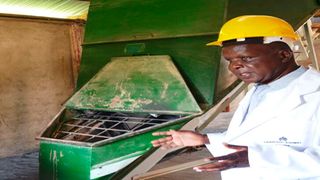
Patrick Wambani inspects poultry feeds in the warehouse at Sashishi Animal Feeds firm in Mumias town.
| Shaban Makokha | Nation Media GroupSeeds of Gold
Premium
Patrick Wambani: I mill my pension from livestock feeds every month
Dressed in a white overcoat, a yellow cap, gumboots and matching trousers, Patrick Wambani checks his milling machine if it is functioning well.
Soon, the machine would roar to life to begin milling a variety of ingredients to make livestock feeds.
Wambani runs an animal feed production plant in Mumias town, the only one in Kakamega County, competing with the bigger boys who are based in Nakuru, Kisumu and Nairobi.

Patrick Wambani at his animal feeds store in Mumias.
“My firm is named Sashishi Animal Feeds Company and I set it up in 2016,” says the entrepreneur, who retired from Mumias Sugar Company in 2013 after working as a production superintendent manager in the factory department.
Two things encouraged him to start the firm; first is the knowledge he had acquired in production as he worked at the sugar miller and second, devolution of agricultural activities which brought opportunities at the grassroots.
“The county government was promoting agribusiness in particular livestock keeping by giving residents cattle and chickens. This provided a market for feeds,” he says.
He ploughed into the business Sh3 million, part of his retirement package, which went on purchasing of raw materials, processing machines and manpower.
The locally fabricated machines he acquired are a crusher, mixer, weighing scale, stitching equipment and those for packaging.
For the raw materials that include maize bran, wheat pollard, wheat bran, cottonseed cake, sunflower cake and soya seed cake, he established source markets in Kisumu and Nakuru as well as Uganda and Tanzania.
“These raw materials are categorised into two, those that offer energy which include maize bran, wheat pollard, wheat bran, maize grain and hay.
”Cottonseed cake, soya, maize germ and sunflower are protein components, he says.
“Other ingredients we add are lime, bone meal, molasses and mineral salt. Cowry shells are good for calcium.
”The firm makes dairy meals, pig and chicken feeds.“

Patrick Wambani inspects poultry feeds at Sashishi Animal Feeds firm in Mumias town.
We test the ingredients for quality and ensure all the nutritional elements are rightly mixed for balanced rations. The feeds must have premixes (multivitamins),” he notes.
The firm produces at least 80 bags of the various livestock feeds per week.
Sometimes, however, they stretch their production capacity if demand grows.
The feeds are packaged in 70kg, 50kg and 10kg bags, which initially were going for between Sh250 and Sh3,100.“But we increased our prices recently by 2 per cent to cater for high production costs after ingredient prices rose and transportation challenges arising from the Covid-19 pandemic. Still, however, our products are priced affordably, from dairy meal to pig sow and weaner meals as well as the poultry mashes,” says Wambani, 70.
While he sells the animal feeds to individual farmers, his biggest market is the County Government of Kakamega, where he has a tender to supply to their smart farms.
The county has created four smart dairy farms in Kholera, Bukura, Kabras and Lugari that serve as learning centres for dairy farmers, students from polytechnics and other tertiary institutions.
“I also supply feeds to dairy cooperative societies in Ikolomani, Khwisero and Malava and local agrovet shops,” says Wambani, adding his farm provides students with practical attachment.
According to him, the business is not only capital intensive but also one needs an array of licences that are costly.
“To start the processing enterprise, I had to acquire a permit from the county government as well as National Environment Management Authority (Nema), public health and Kenya Bureau of Standards (Kebs) certification,” he says.
“Getting the certification from Kebs was one of the biggest challenges as it involved a lot of back of forth.
”His affordable prices is one of his strategies to compete with the big boys, he says.
“Securing the county government market has also given my firm a competitive edge.
”His goal is to set up a laboratory for the business and acquire more modern machines for production.
“I currently take my samples of raw materials and finished products to the Kenya Plant Health Inspectorate Service (Kephis) for testing which delays the production and supply chains.
”He notes that the total investment in the business, which has gone to construction of the premises, purchase of three lorries and a van for transportation purposes, drilling water plus purchase of the processing machines has hit Sh40 million.
“Production of animal feeds is dynamic, it is evolving in response to rapidly increasing demand for livestock products. One must stay ahead of the game,” he says of the lesson he has learnt.
He is working on adding essential oils to his feeds that are beneficial to animals and using other additives such as enzymes.
Sashishi Animal Feeds has employed six workers, a man and a lady who serves as the marketing and sales executive as well as several casual staff who are hired on need basis.
He asks local farmers to diversify their crops, assuring them that Sashishi provides a ready market for soya, maize and groundnuts.
David Ayoyi, an agronomist at Kakamega County government, notes that before venturing into production of animal feeds, one must have a reliable source of raw materials. “The materials should give him quality feeds. There must be carbohydrates, proteins, minerals and vitamins to give a balanced diet to livestock,” says Ayoyi.
The feed ingredients should be stocked well to avoid cases of aflatoxin contamination.
“One must ensure they have enough space to hygienically store the raw materials and the processed feed before they are sold.”





